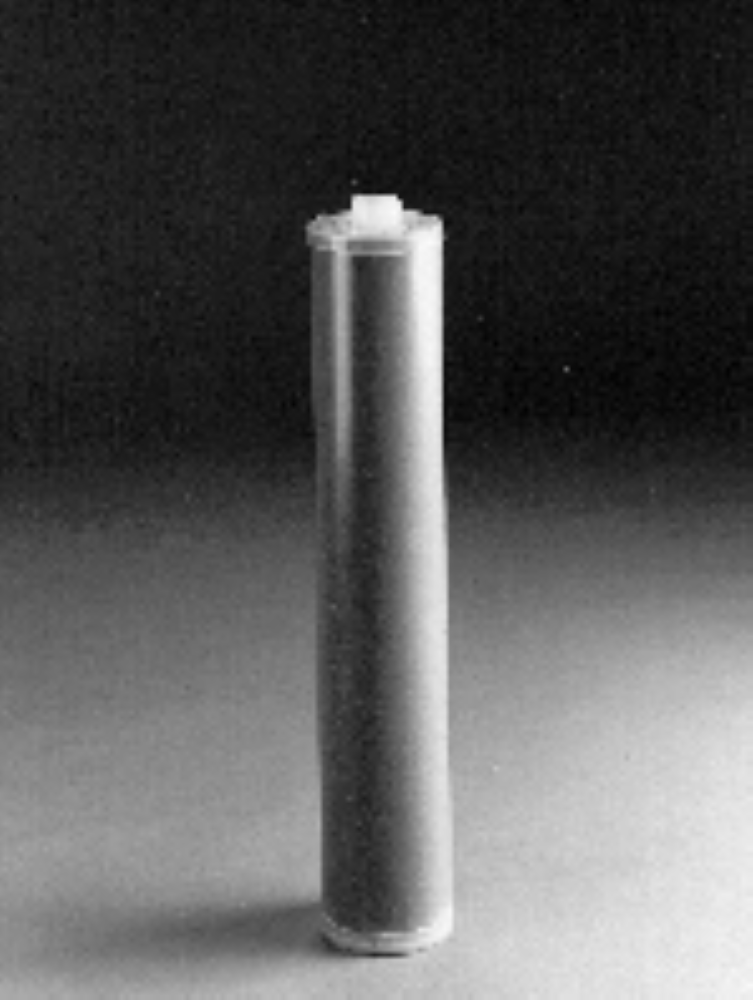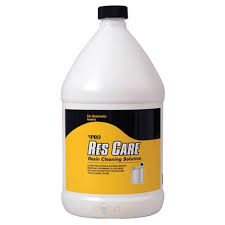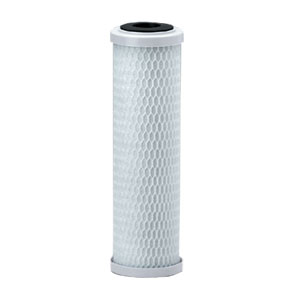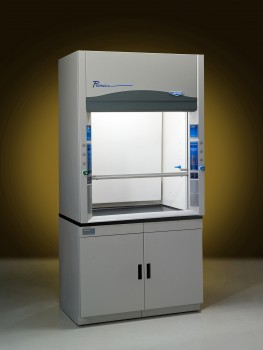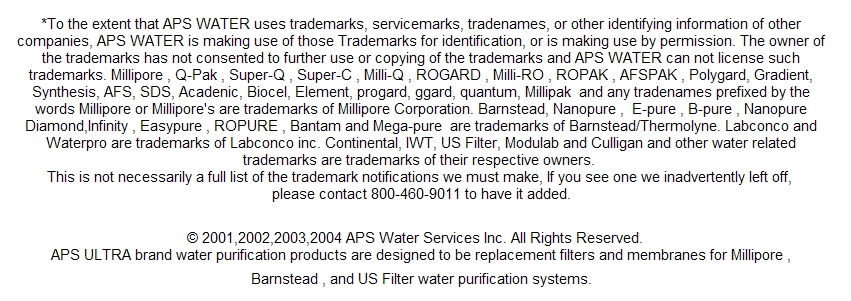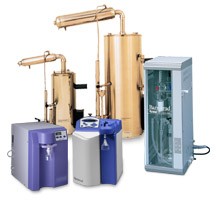 |
Need a New Laboratory Water System?
We have many to choose from. We can save you thousands on
Complete Systems and replacement filters for most brands. |
Travelers : Treatment of Water to Make it Safe for Drinking
Treatment of Water to Make it Safe for Drinking
In areas where tap water is not chlorinated or where sanitation is poor, there are several alternative methods for ensuring water is safe to drink. These include boiling the water, chemically disinfecting it, filtering it, using various combinations of the previously stated methods, or buying bottled water. Remember: if the tap water is not safe to drink in the area you are visiting, do not use it to reconstitute juice or to rinse fresh fruits and vegetables. Also avoid ice made from tap water.
Below we describe ways to make sure water is safe to drink.
Bottled Water
Bottled water from a trusted source is a recommended alternative to tap water. Before drinking, be sure all bottled beverages have fully sealed caps. If seals are not intact, the bottles may have been refilled.
Boiling Water
Boiling water is the best method for making water safe to drink. Boiling water as recommended will kill bacterial, parasitic, and viral causes of diarrhea. Adding a pinch of salt to each quart will improve the taste.
Directions for Boiling Water
Boil water vigorously for 1 minute and allow it to cool to room temperature (do not add ice).
At altitudes greater than 6,562 feet (>2,000 m), boil water for 3 minutes or use chemical disinfection after water has been boiled for 1 minute.
Chemical Disinfection
If boiling water is not possible, chemical disinfection with iodine (e.g., Globaline, Potable-Aqua, or Coghlan’s, found in pharmacies and sporting goods stores) is another method for making water safer to drink. Cryptosporidium (a parasite that can cause diarrhea) and other coccidian parasites (e.g., Cyclospora, Toxoplasma) might not be killed by this method. Cloudy water should be strained through a clean cloth into a container to remove any sediment or floating matter, and then the water should be treated with iodine.
Directions for disinfecting water with iodine
Iodine tablets
Follow the tablet manufacturers' instructions.
If water is cloudy, double the number of tablets.
If water is extremely cold, less than 5° C (41° F), an attempt should be made to warm the water, and the recommended contact time (standing time between adding a chemical disinfectant to the water and drinking the water) should be increased to achieve reliable disinfection.
Note: be sure the tablet size is correct for a Liter of water.
Tincture of Iodine - measure out your dose to water.
If using tincture of iodine 2% solution, add 5 drops to a Liter or Quart of clear water. If the water is cloudy, add 10 drops per Liter or Quart. (Note: 20 drops=1 ml.)
Allow the water to stand for 30 minutes before drinking when the water temperature is at least 25°C (77°F). Increase the standing time for colder water: (e.g., for each 10° less than 25°C (77°F), allow the water to stand for double the time before drinking it.
Crystalline Iodine (found at some chemical companies and sporting goods stores) First make a saturated solution and then measure your own dose to add to water. The crystalline form stores well indefinitely and new batches of the saturated solution can be made from a small amount of crystals each time you take a trip.
To prepare a stock of Crystalline Iodine saturated solution:
Place 4-8 grams of crystalline iodine into a 1-2 oz container and fill with water. Note: 1oz=6 teaspoons.
Warning: crystalline iodine at 4-8 grams is a lethal dose if accidentally swallowed in a single dose. Keep out of the reach of children.
Shake the bottle vigorously for 1 minute. Allow several additional minutes for the iodine to maximally dissolve in the available water. Some crystals should always be visible; if they totally dissolve, then more crystals should be added to the container to insure that iodine saturation of the stock solution has been achieved.
If the water to be treated is clear, add 13 ml of saturated iodine solution -- liquid above the crystals, not the crystals themselves -- per Liter or Quart. Note: 5 ml= 1 teaspoon. 13 ml = about 2.5 teaspoons
In cloudy water, add 26 ml of saturated solution per Liter or Quart.
Note: Allow the solution to stand 20 minutes before drinking the disinfected water when the water temperature is 20-25°C (68-77°F). Increase the standing time with colder water. For each 10° less than 25°C (77°F), allow the water to stand for double the time before drinking.
Portable Water Filters
Certain types of portable water filters can also remove some types of infectious agents from drinking water. However, most of the portable filters on the market do not effectively remove viruses, thus chemical disinfection of water is needed after filtering with such filters to make the water safer for drinking. Some portable water filters designed to remove parasites (Giardia/Cryptosporidium) have an "absolute” pore sizes of 0.1 to 1-micrometer and, therefore, may also remove most diarrhea-causing bacteria.
See the Division of Parasitic Diseases' Guide to Water Filters and Bottled Water to learn about different filters and those that filter Cryptosporidium. Viruses are smaller than 0.1 micron and will NOT be removed by filters with a pore size of 0.1 or larger. To kill viruses that may pass through these filters, add iodine (as described above) to the filtered water before you drink it.
Note: Chlorine in various forms has also been used for chemical disinfection. However, it is not as reliable as iodine for killing disease causing organisms in the wide range of water-quality conditions that travelers might encounter.
Warnings
Crystalline iodine 4-8 grams used in a stock solution constitutes a human lethal dose if accidentally swallowed in a single dose. Keep out of the reach of children.
Water that has been disinfected with iodine is NOT recommended for pregnant women, people with thyroid problems, those with known hypersensitivity to iodine, or continuous use for more than a few weeks at a time.
Date: May 27, 2005
Content Source: National Center for Infectious Diseases, Division of Global Migration and Quarantine
http://www.cdc.gov/travel/water_treatment.htm
|

Images are representative of the products. Images may or may not be of the actual product. If it is important e-mail us for an actual image if available.
* Flat Rate UPS shipping when able to ship via UPS and is in the USA excluding Hawaii and Alaska.
Larger Items may not be able to ship via UPS, in that case freight charges will be quoted seperately.
International shipping will be quoted after the order is placed. You will have the opportunity to cancel before we finalize your order.
Terms and conditions
Credit Application
Privacy
Policy
Google Apps
List All Products
|





